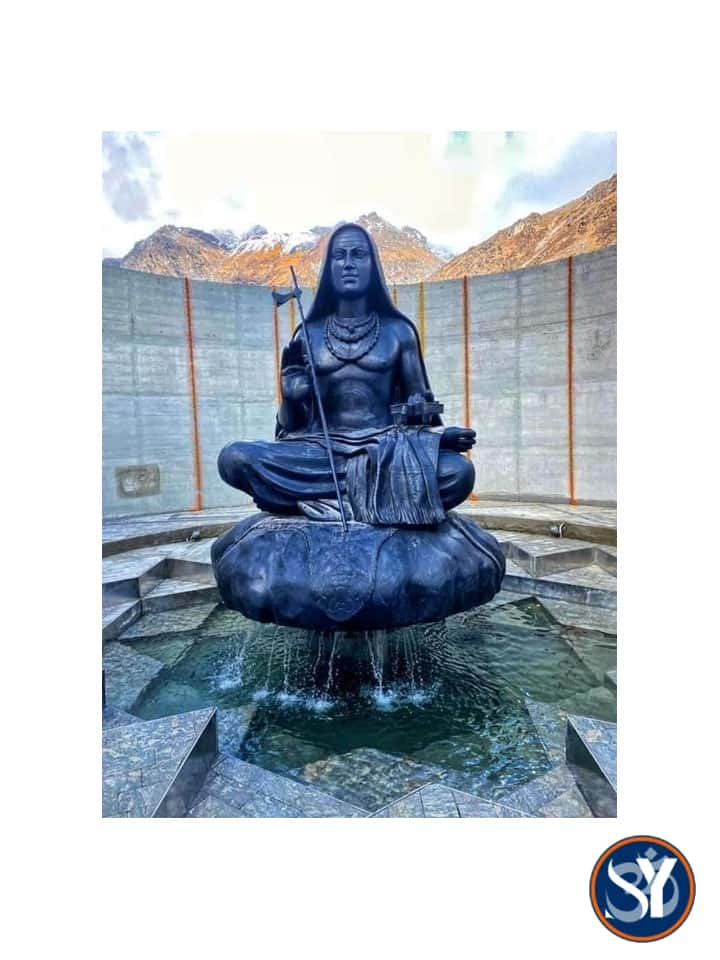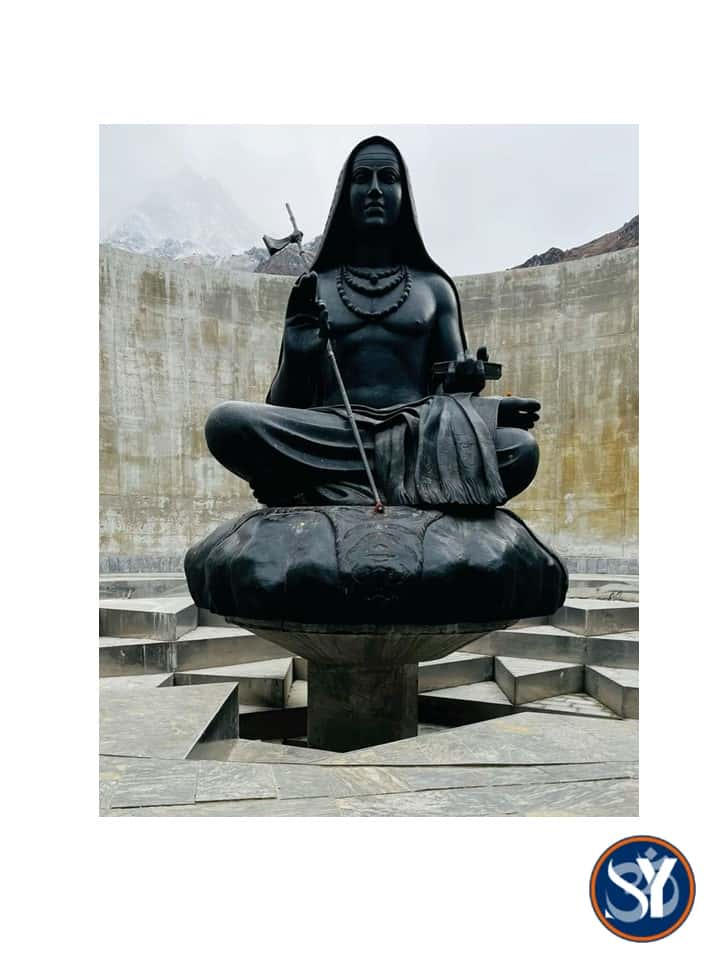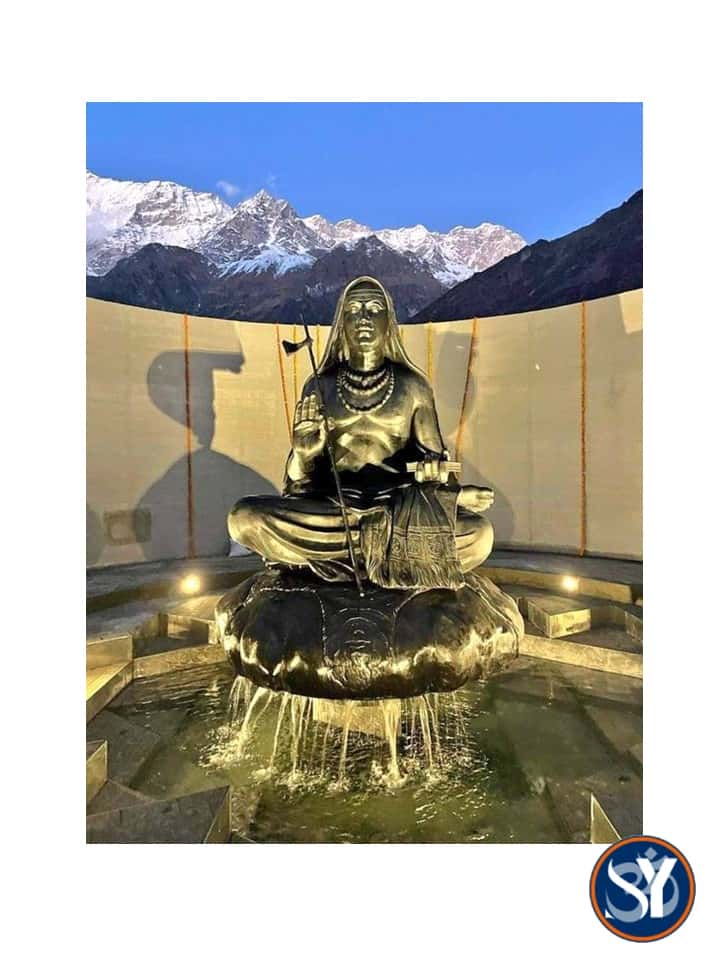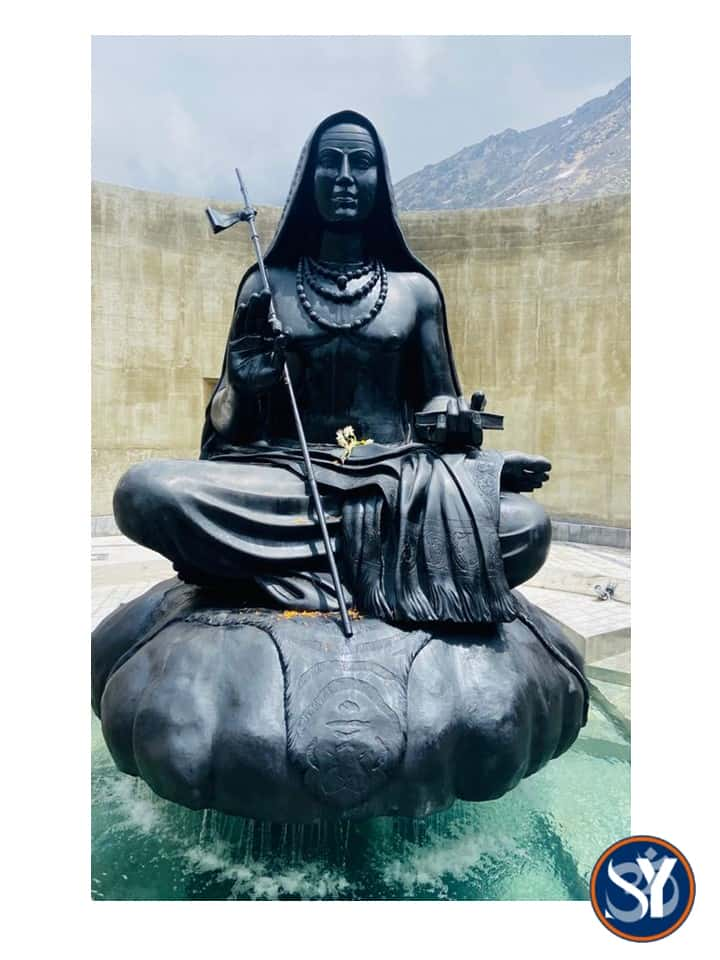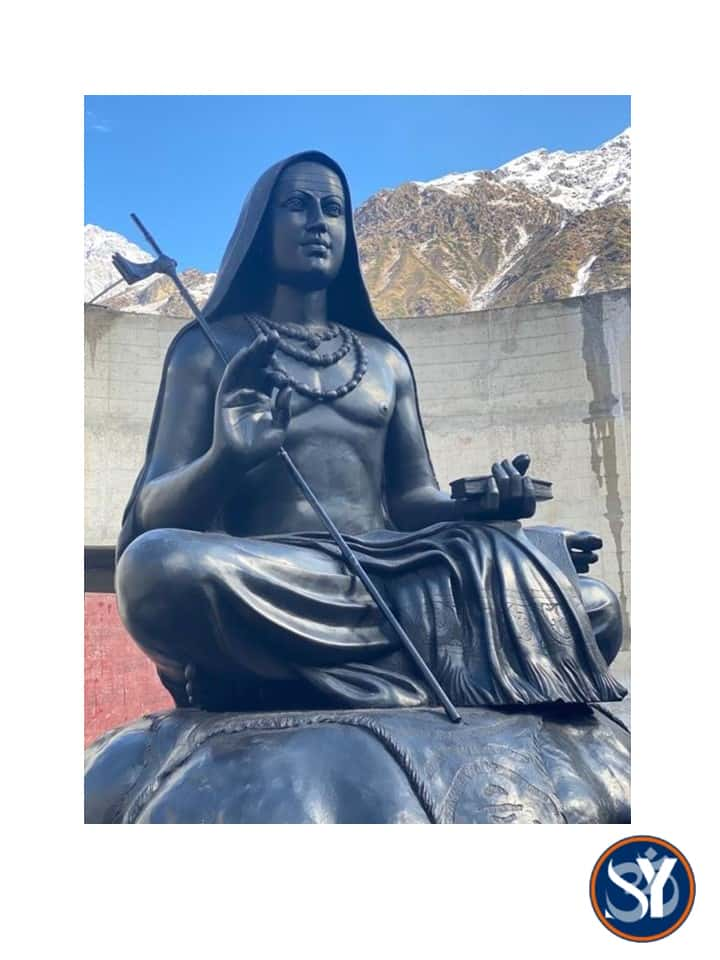Introduction to Guru Adi Shankaracharya Statue
Guru Adi Shankaracharya Statue in Kedarnath: Welcome to Kedarnath, a sacred abode nestled amidst the majestic Himalayas in India. Within this divine heaven lies the Guru Adi Shankaracharya Statue. Its an embodiment of wisdom and enlightenment revered by countless devotees.
Join us as we delve into the rich history and profound significance of this ancient idol. It holds a special place in the hearts of those who undertake the revered Chardham Yatra pilgrimage. Prepare to be captivated by tales steeped in mythology, rituals brimming with devotion, and preservation efforts fuelled by unwavering faith. Let’s unravel the captivating story behind Guru Adi Shankaracharya Statue in Kedatnath.
The Significance of Kedarnath in Hinduism
The significance of Kedarnath in Hinduism is immense. Located in the majestic Himalayas, Kedarnath holds a special place in the hearts of devout Hindus. Devotees believe it to be one of the holiest pilgrimage sites among the twelve Jyotirlingas.
Kedarnath is surrounded by breath-taking natural beauty, with snow-capped peaks and pristine landscapes that create a truly divine atmosphere. Many believe that visiting this sacred site can wash away their sins and grant them spiritual liberation.
According to Hindu mythology, it was at Kedarnath that Lord Shiva took refuge after the Kurukshetra war. The temple dedicated to Lord Shiva stands as a symbol of his divine presence in this sacred land.
Pilgrims from all over India embark on the arduous Chardham Yatra to seek blessings at Kedarnath. The journey itself is considered an act of devotion and self-discovery. It involves trekking through treacherous terrains and enduring harsh weather conditions, but devotees endure these hardships with unwavering faith.
At Kedarnath, pilgrims not only pay homage to Lord Shiva but also immerse themselves in various rituals and ceremonies. They offer prayers, light lamps, perform ablutions in the holy Mandakini River, and seek blessings for prosperity and well-being.
The impact of visiting Kedarnath goes beyond just religious beliefs; it has a profound effect on pilgrims’ spiritual journeys. The tranquil surroundings allow individuals to disconnect from worldly distractions and connect deeply with their inner selves. It provides an opportunity for introspection and self-reflection. Efforts are being made to preserve the sanctity of this ancient site while ensuring its accessibility for devotees.
Guru Adi Shankaracharya Statue Photos
History of the Guru Adi Shankaracharya Statue in Kedarnath
The history of Guru Adi Shankaracharya Statue in Kedarnath holds great significance in Hinduism. The Statue is believed to be a representation of Guru Adi Shankaracharya Statue, who was a renowned philosopher and spiritual leader.
According to ancient scriptures and legends, it is said that Guru Adi Shankaracharya Statue visited Kedarnath during his lifetime and established a temple dedicated to Lord Shiva. He placed the sacred the Statue inside the temple, which became an important pilgrimage site for devotees.
The exact origins of the Statue are shrouded in mystery, with some accounts suggesting that it was carved by divine beings themselves. Regardless of its origin, the Statue has been revered by generations of pilgrims who visit Kedarnath as part of their spiritual journey.
Devotees believe that worshipping the Guru Adi Shankaracharya Statue brings blessings and spiritual upliftment. It is considered auspicious to offer prayers and perform rituals in front of the sacred idol.
Over time, various rituals and ceremonies have been performed at the Statue to honor its significance. These include abhishekam (ritual bathing), aarti (offering of light), and recitation of mantras. These practices help create a powerful energy around the idol and foster devotion among pilgrims.
For those undertaking Chardham Yatra, visiting Kedarnath holds immense importance due to its association with both Lord Shiva and Adi Sri Guru Shankaracharya’s legacy. The presence of this historic Statue adds another layer of spirituality to their pilgrimage experience.
Efforts have been made over the years to preserve this ancient Statue so that future generations can continue to benefit from its sanctity. Conservation measures are taken regularly by authorities responsible for maintaining temples in order to ensure its longevity.
Importance of the Statue for devotees in Chardham Yatra
The Statue of Adi Sri Guru Shankaracharya holds immense significance for devotees undertaking the Chardham Yatra. It is believed to be a sacred representation of the revered saint, who was instrumental in reviving Hinduism and establishing the Advaita Vedanta philosophy.
For devotees, this Statue serves as a symbol of devotion and reverence towards Guru Shankaracharya. It acts as a medium through which they can connect with his teachings and seek his blessings. The presence of the Statue in Kedarnath adds an aura of spirituality to the entire pilgrimage.
During their visit to Kedarnath, pilgrims make it a point to offer prayers and perform rituals at this holy shrine. They believe that by seeking blessings from Guru Shankaracharya through his Statue, their spiritual journey will be enhanced, and they will receive divine guidance on their path towards self-realization.
Devotees also believe that paying homage to this ancient statue brings them closer to understanding the profound wisdom imparted by Guru Shankaracharya. The teachings he propagated continue to inspire millions across generations, making him an iconic figure in Hindu philosophy.
The presence of such a revered Statue during the Chardham Yatra not only strengthens one’s faith but also reinforces their commitment towards following dharma (righteousness) in all aspects of life.
In essence, the importance of this Statue lies in its ability to invoke deep spiritual experiences within devotees during their journey. Its existence serves as a constant reminder for pilgrims about the rich heritage and wisdom encapsulated within Hinduism.
Rituals and ceremonies performed at the Statue
Rituals and ceremonies performed at the Guru Adi Shankaracharya Statue in Kedarnath hold immense significance for devotees on their Chardham Yatra. These rituals are steeped in tradition and spirituality, creating a divine atmosphere that resonates with pilgrims.
One of the most important rituals is the Abhishekam, where sacred water from the holy Mandakini River is poured over the Statue. This act symbolizes purification and devotion, as devotees believe that it washes away impurities and brings them closer to enlightenment.
Another significant ceremony is the Aarti, which takes place every morning and evening. Devotees gather around the Statue, offering flowers, incense, and lamps while chanting hymns in praise of Guru Shankaracharya. The rhythmic sounds create an aura of reverence and devotion that fills the air.
Pilgrims also engage in Pradakshina or circumambulation around the Statue. This ritual involves walking clockwise around the deity as a mark of respect and surrender to Guru Shankaracharya’s teachings. It is believed to bring blessings and fulfil wishes.
Throughout these rituals, devotees offer prayers seeking spiritual guidance, wisdom, prosperity, health, or any other specific need they may have. They pour their hearts out to Guru Shankaracharya through these ancient practices passed down through generations.
The energy during these ceremonies is palpable — a mix of faith-filled anticipation and deep connection with divinity. Pilgrims experience profound peace as they immerse themselves in these sacred moments.
The rituals performed at Adi Sri Guru Shankaracharya’s Statue connect devotees not only with him but also with centuries-old traditions ingrained in Hinduism. These ceremonies serve as reminders of our spiritual journey towards self-realization and union with God – an integral part of Chardham Yatra.
Impact of the Statue on pilgrims visiting Kedarnath
The Guru Adi Shankaracharya Statue in Kedarnath holds immense significance for the pilgrims visiting this sacred site. The impact of this revered idol is palpable, as it evokes a deep sense of devotion and spirituality among devotees.
For many pilgrims, the sight of the Statue is a powerful reminder of their faith and connection to Hinduism. It serves as a symbol of Lord Shiva’s divine presence in Kedarnath, and devotees feel blessed to have the opportunity to offer their prayers in front of it.
The Statue also has a transformative effect on pilgrims’ spiritual journeys. As they stand before this ancient idol, they are filled with a profound sense of peace and tranquility. Many describe experiencing an overwhelming sense of joy, love, and surrender during their interactions with the Statue.
Furthermore, being in the presence of such a revered deity instills a deep sense of reverence and humility within pilgrims. They often find themselves reflecting on their own lives and seeking guidance from Lord Shiva through their prayers.
Moreover, the impact extends beyond just personal experiences. The collective energy generated by thousands of devotees coming together to worship at Kedarnath creates an atmosphere charged with spiritual fervor. This shared devotion fosters unity among people from different walks of life who come together under one roof for a common purpose – to seek blessings from Lord Shiva.
The Guru Adi Shankaracharya Statue in Kedarnath leaves an indelible mark on every pilgrim who visits this holy shrine. Its profound impact resonates not only within individual hearts but also across communities united in faith. The power emanating from this sacred idol continues to inspire countless souls on their spiritual journey towards self-realization and union with divinity.
Preservation efforts for the Statue
Preservation efforts for the Statue at Kedarnath are of utmost importance to ensure that this sacred idol remains intact for generations to come. The centuries-old statue of Guru Adi Shankaracharya Statue holds immense significance in Hinduism, and it is crucial to protect and maintain its integrity.
The harsh weather conditions in the Himalayas pose a constant threat to the Statue’s preservation. Freezing temperatures, heavy snowfall, and strong winds can cause damage over time. To combat these challenges, various measures have been taken by the authorities responsible for maintaining Kedarnath Shrine.
Regular inspections and maintenance checks are conducted by experts who specialize in preserving ancient artifacts. Special coatings and sealants are applied to safeguard against moisture, preventing any potential deterioration. Additionally, climate-controlled chambers have been installed within the shrine premises to regulate temperature and humidity levels around the Statue.
Awareness campaigns emphasizing the importance of conservation have also played a vital role in ensuring public participation. Pilgrims visiting Kedarnath are educated about proper etiquette while paying their respects to avoid inadvertently causing harm or degradation.
Efforts are being made not only towards physical preservation but also documentation and digitization of historical records related to the Statue’s origin and significance. This ensures that even if any unforeseen circumstances arise, valuable information will be preserved for future generations.
It is heartening to see how dedicated individuals work tirelessly behind-the-scenes with unwavering commitment towards preserving this cherished symbol of faith at Kedarnath. Their efforts serve as a reminder of our responsibility as stewards of our cultural heritage – protecting it today so that future generations can continue experiencing its profound spirituality.
Importance Of Chardham Yatra in Hinduism
In the vast tapestry of Hinduism, the Chardham Yatra holds immense significance. It is a journey that takes devotees through four sacred sites. These including Kedarnath, where the Guru Adi Shankaracharya Statue stands as a symbol of devotion and spiritual enlightenment.
The history and importance of this ancient Statue are deeply intertwined with the religious fabric of India. For centuries, pilgrims have flocked to Kedarnath to seek blessings from Lord Shiva. And pay their respects toGuru Adi Shankaracharya Statue. The Statue serves as a beacon of faith and inspiration for those embarking on the Chardham Yatra.
The rituals performed at this sacred site are steeped in tradition and reverence. Devotees participate in elaborate ceremonies such as Abhishekam (ritual bathing), puja (worship), and aarti (devotional song) to express their devotion and seek divine blessings. These rituals create an atmosphere charged with spirituality that leaves a lasting impact on all who visit.
The preservation efforts for the Guru Adi Shankaracharya Statue are crucial in maintaining its sanctity for generations to come. With advancements in technology, measures have been taken to protect this priceless artefact from natural disasters like earthquakes or harsh weather conditions.
Now let’s delve deeper into the broader significance — The Chardham Yatra itself carries immense importance within Hinduism. that undertaking this pilgrimage can cleanse one’s soul, wash away sins accumulated over lifetimes, and pave the way towards moksha (liberation). The journey not only offers physical rejuvenation but also provides an opportunity for spiritual growth and self-discovery.


